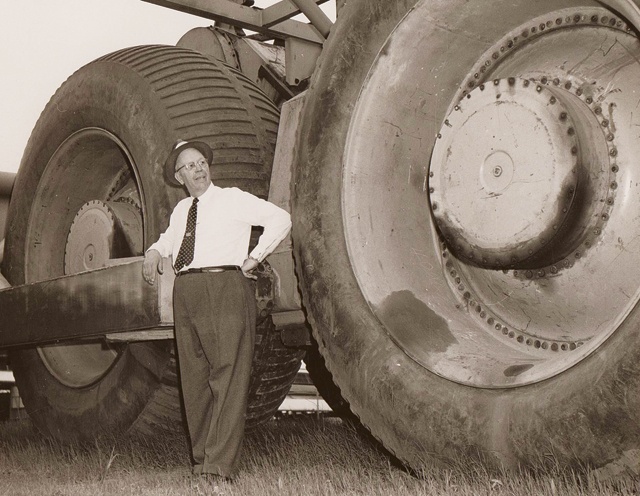When it came to moving heaven and earth, R.G. LeTourneau paved the way.
First his earthly accomplishments: LeTourneau was a prolific inventor. Among his 299 patents is one in 1953 for a “bulldozing machine,” an early version of the modern bulldozer. Other patents included a portable crane, powered rollers used to tamp down pavement, bridge spans, mobile platforms for offshore oil drilling and the electric-powered wheel. He was responsible for making 70 percent of the earthmoving equipment used by the Allies in World War II to build runways, roadways and shelters. His inventions, still at work today, started a revolution that turns the wheels of our modern world.
When it came to spiritual matters, LeTourneau was on equally solid ground. In 1946, he and his wife, Evelyn, founded LeTourneau University in Longview to perpetuate his spiritual legacy. And they donated 90 percent of their fortune to Christian ministries.
“He had a can-do spirit,” says Dale Lunsford, president of LeTourneau University.
In the early 1900s, mules or tractors pushing scraper blades were man’s only options when he needed to move dirt, unless he used a shovel. LeTourneau mobilized scraper blades, inventing the bulldozer. He was the first to use rubber tires on behemoth machines, powering wheels individually with electric motors. Today’s heavy equipment couldn’t shove and haul so much, so far, so fast without his inventions. He even devised something called the Tournalayer, which produced prefabricated concrete bungalows “like a chicken lays an egg,” leaving a legacy of modest homes of enviable economy studied by architectural students today.
But his road to success was uphill, riddled with potholes of poverty and debt. It took him 30 years to discover his destiny, spending the rest of his life blazing trails to pursue it.
Born in 1888 in Vermont, young Bob (later known as R.G.) earned a reputation as a ne’er-do-well. At 12, he built his first invention: a heifer-pulled snowplow. It might have worked, but the heifer wouldn’t cooperate. At 17, he quit high school and, moving to Minnesota, Oregon and then California, began his on-the-job education in manual trades, learning to work faster, not harder, eagerly completing one job to begin the next. In California, LeTourneau was introduced to welding, and he pioneered the practice of never using a bolt where a weld would do. Then, on his first earthmoving job, he realized: “I wanted to move dirt. Lots of dirt.”
LeTourneau, who started his own land-clearing business in Stockton, California, after World War I, noticed weaknesses in existing machinery and remedied them himself. When he got more earthmoving contracts than he could handle, he built machines that did more work. Then his Carryall scraper—a motor-operated badger on wheels doing the work of 1,000 men and mules—pushed him into big-league manufacturing.
LeTourneau constantly came up with ways to move more dirt in less time for less money, inventing machines that defied the common sense of his day. In the early 1930s, he gave up the earthmoving business and dedicated himself full time to manufacturing heavy equipment.
Existing tractors limited his Carryall scraper. In 1937, while recovering from a car accident, he spent six months in a full-body cast and designed a stretcher to wheel himself through his factory. That’s when he got the idea for the Tournapull to pull his scraper. With two rubber tires and a two-way, 90-degree swing, it looked as useless as a sulky without a horse—until hitched to the Carryall. “Called crazy again,” he said, “I knew I was on the right track.” Sure enough, after World War II, other manufacturers raced to catch up with him when they realized the improvement the machine brought to earthmoving.
In 1946, he settled in Longview. There he converted an abandoned Army hospital into a technical institute, now LeTourneau University, where students could earn a living while learning in a Christian environment. From age 30, he had dedicated himself as “God’s businessman.”
Success brought him opportunities to share his faith, flying around the world in a converted A-26 glass-nosed bomber, saying, “I am just a mechanic whom the Lord has blessed.” At age 65, LeTourneau sold his line of earthmoving equipment and three of five factories, agreeing to a five-year exile from the industry. His Christian compassion motivated him to continue inventing machines to help those living in underdeveloped but resource-rich nations improve their quality of life.
When he was 70, LeTourneau invented a digger that scoops 150 tons of dirt in two minutes (one gulp each of two 75-ton payload buckets), and a train that hauls 150 tons (the weight of a blue whale) over all terrains. Whenever his wife asked him if he was going back to work after supper, he’d say, “No, just going back to play with my big toys for a while.”
In 1969, LeTourneau died after a stroke. He was 80. The steel domes beneath which he erected his giant machines remain a Longview landmark. His earthmoving innovations continue to change the landscape.
“I like to think his greatest legacy, however, is LeTourneau University and the unique education our students experience,” says Lunsford, the university’s president. “It’s a hands-on, world-as-your-classroom curriculum that emphasizes professional excellence and Christian character.”
——————–
K.A. Young, a member of Wood County Electric Cooperative, lives in Quitman.


